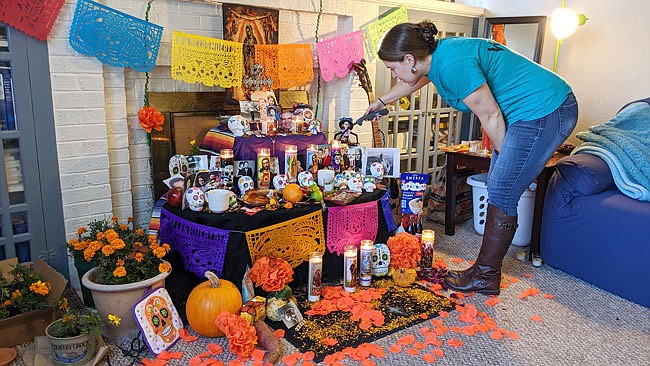Halloween is a day of ritual.
Families carve pumpkins to grin into the night. They don costumes and take to the streets. "Trick or treat!" children chorus, receiving candy in return. For many, the holiday ends that night, as soon as the cold and dark hasten the children on their way home to sort their goodies.
But for others, once they've "finished with the candy part, it's the real day," said the Rev. Joseph Abah of St. Peter Catholic Church in Fulton.
Many are familiar with the idea Halloween is short for All Hallows' Eve. What it's the "eve" of depends on your background: A number of cultures and religious sects celebrate versions of the holy day, which at their root involve remembering and praying for family members and loved ones who have passed on.
At least two variations of the day were celebrated Friday in Fulton, both at Westminster College.
All Saints' Day
Just after noon, St. Mary the Virgin, Aldermanbury played host to a Catholic mass. Bright beams of sunlight belied the chill outside, heating the solemn worshippers in their stiff-backed pews. Abah led the service: a mix of prayer, praise, readings and Holy Communion.
For that brief time, according to their beliefs, the worshippers join those who have passed away in their worshiping in heaven.
"All Saints' Day is a special day set aside to commemorate all those who are in heaven," Abah explained.
It's not just to remember the 10,000 or so officially recognized Catholic saints, "there are way more in heaven than those who are recognized," he said.
All Saints' Day is followed by All Souls' Day, which commemorates all Christians who have died. In the Catholic Church, dying a Catholic is not an automatic ticket to heaven - some souls must pause in purgatory to complete their purification.
"Every day, we either add to our journey (toward heaven) or take away from it," Abah said. "The saints in heaven are silently cheering us on."
On All Souls' Day, Catholics pray for those souls.
Abah said even within Catholicism, some youths are losing sight of the meaning and importance of Halloween, and it makes him sad to see the change.
Da de los Muertos
All Saints' Day shares some clear DNA with Da de los Muertos, a Mexican holiday whose name translates to "Day of the Dead." The celebration predates the arrival of Catholicism in Mexico and has its roots as a holiday celebrated by the indigenous Aztec, dedicated to the goddess Mictecacihuatl.
After Spanish conquistadors brought Catholicism to Mexico, the Catholic traditions gradually mingled with the preexisting rituals to produce the current three-day fiesta. Oct. 31 is for the spirits of children, Nov. 1 for visiting adults and Nov. 2 for decorating graves in the cemetery.
Today, Da de los Muertos is celebrated all across Latin America and beyond.
The Catholic Mass' solemn hymns and white robes contrast dramatically with the bright colors of the ofrenda set up Friday afternoon at the Center for Faith and Service.
"It's been a steady assembly all month," said Kiva Nice-Webb, the center's director.
An ofrenda is a sort of homemade altar, designed to entice departed souls back for a visit to hear the prayers of their loved ones.
Ofrendas vary but are often laden with marigolds, favorite foods, photographs and memorabilia of the dead, and traditional goodies such as the iconic decorated sugar skulls.
The ofrenda at Westminster was the idea of student Cameron Gehler, who's interested in the rituals and traditions of many religions. He was out of town Friday but spent months growing marigolds and weeks collecting memorabilia from his fellow students.
"I thought since the Center for Faith and Service is a place where we can learn about and share faith traditions, it was a good idea," Nice-Webb said.
This particular ofrenda featured pictures of both loved ones (a much-missed pet dog and Nice-Webb's grandfather) and other deceased people who'd influenced students' lives (Anthony Bourdain, a Buddhist religious figure, the Kennedys). Loaves of pan de muerto mingled with Snickers bars and candles.
"The basic idea is that you're still connected to the people who've passed on," Nice-Webb said. "Many cultures have a version of that idea."

